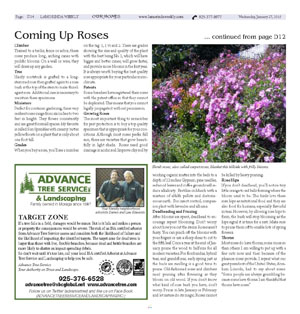|
|
Published January 27, 2016
|
Digging Deep-Gardening with Cynthia Brian
|
| Coming Up Roses |
| By Cynthia Brian |
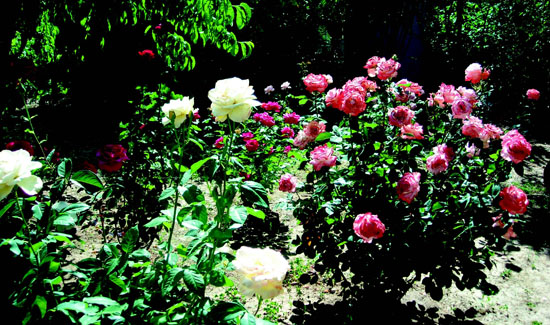 |
| A rose garden can have various types and colors of roses. Photos Cynthia Brian |
"I don't know whether nice people tend to grow roses or growing roses makes people nice." - Roland A. Browne
 Roses are the most popular bloomers in the world with a long and colorful history as symbols of love, war, beauty, friendship and politics. According to fossil evidence, the majestic rose is older than humankind, dating to over 35 million years ago. The cultivation of garden roses most likely began in China over 5,000 years ago. Throughout the Northern Hemisphere, the genus Rosa includes 150 species. Roses were used for celebrations, perfume, medicine, fashion and décor.
Roses are the most popular bloomers in the world with a long and colorful history as symbols of love, war, beauty, friendship and politics. According to fossil evidence, the majestic rose is older than humankind, dating to over 35 million years ago. The cultivation of garden roses most likely began in China over 5,000 years ago. Throughout the Northern Hemisphere, the genus Rosa includes 150 species. Roses were used for celebrations, perfume, medicine, fashion and décor.
 The Persians considered the rose a representation of love, the Romans planted extensive public rose gardens, the Greeks wrote about roses, and pagan goddesses were associated with this fragrant flower. During the 15th century, "The War of the Roses" saw the House of York with its white rose fighting against the red rose House of Lancaster for control of England. In France, Napoleon's wife Josephine planted an extensive rose collection at Chateau de Maimason which is where the famed illustrator, Pierre Joseph Redoute, completed what is considered one of the finest records of botanical illustration with his watercolor collection, "Les Rose."
The Persians considered the rose a representation of love, the Romans planted extensive public rose gardens, the Greeks wrote about roses, and pagan goddesses were associated with this fragrant flower. During the 15th century, "The War of the Roses" saw the House of York with its white rose fighting against the red rose House of Lancaster for control of England. In France, Napoleon's wife Josephine planted an extensive rose collection at Chateau de Maimason which is where the famed illustrator, Pierre Joseph Redoute, completed what is considered one of the finest records of botanical illustration with his watercolor collection, "Les Rose."
 Contrary to popular belief, roses are extremely easy to grow with relatively low maintenance and rewards that far outweigh any efforts on their behalf. This is the time of year when heavy pruning is in order as well as planting bare root specimens.
Contrary to popular belief, roses are extremely easy to grow with relatively low maintenance and rewards that far outweigh any efforts on their behalf. This is the time of year when heavy pruning is in order as well as planting bare root specimens.
 Let's look at the different kinds of roses and how to care for them:
Let's look at the different kinds of roses and how to care for them:
 Floribunda
Floribunda
 These versatile sun-loving shrubs have the most blossoms of the hybrid teas setting clusters of three to 15 blossoms per stem.
These versatile sun-loving shrubs have the most blossoms of the hybrid teas setting clusters of three to 15 blossoms per stem.
 Hybrid Tea
Hybrid Tea
 Ideal for cutting, these tall, striking long-stemmed roses are the ones you will find in florist bouquets. Hybrid teas have only one flower per stem with many varieties revealing a lovely rose fragrance.
Ideal for cutting, these tall, striking long-stemmed roses are the ones you will find in florist bouquets. Hybrid teas have only one flower per stem with many varieties revealing a lovely rose fragrance.
 Grandiflora
Grandiflora
 These repeat bloomers are a cross between a floribunda and a hybrid tea. Growing up to six feet tall, these elegant roses feature clusters on shorter stems.
These repeat bloomers are a cross between a floribunda and a hybrid tea. Growing up to six feet tall, these elegant roses feature clusters on shorter stems.
 Shrub and Carpet
Shrub and Carpet
 Disease resistant, compact growth, impressive clusters with little to no maintenance makes these a great selection for hillsides. These landscape roses spread growing close to the ground, which is why they are often referred to as "carpet roses." Whack them off at the end of the season for even more blooms in the months to come.
Disease resistant, compact growth, impressive clusters with little to no maintenance makes these a great selection for hillsides. These landscape roses spread growing close to the ground, which is why they are often referred to as "carpet roses." Whack them off at the end of the season for even more blooms in the months to come.
 Climber
Climber
 Trained to a trellis, fence or arbor, these roses produce long, arching canes with prolific blooms. On a wall or wire, they will dress up any garden.
Trained to a trellis, fence or arbor, these roses produce long, arching canes with prolific blooms. On a wall or wire, they will dress up any garden.
 Tree
Tree
 Hardy rootstock is grafted to a long-stemmed rose then grafted again to a rose bush at the top of the stem to make this elegant rose. Additional care is necessary to maintain these specimens.
Hardy rootstock is grafted to a long-stemmed rose then grafted again to a rose bush at the top of the stem to make this elegant rose. Additional care is necessary to maintain these specimens.
 Miniature
Miniature
 Perfect for container gardening, these very resilient roses range from six inches to two feet in height. They flower consistently and are great for small spaces. My favorite is called Sun Sprinkles with creamy butter yellow florets on a plant that is only about one foot tall.
Perfect for container gardening, these very resilient roses range from six inches to two feet in height. They flower consistently and are great for small spaces. My favorite is called Sun Sprinkles with creamy butter yellow florets on a plant that is only about one foot tall.
 Grades
Grades
 When you buy a rose, you'll see a number on the tag: 1, 1 1/2 and 2. These are grades showing the size and quality of the plant with the best being No. 1, which will have bigger and better canes, will grow faster, and provide more blooms in the first year. It is always worth buying the best quality rose appropriate for your particular microclimate.
When you buy a rose, you'll see a number on the tag: 1, 1 1/2 and 2. These are grades showing the size and quality of the plant with the best being No. 1, which will have bigger and better canes, will grow faster, and provide more blooms in the first year. It is always worth buying the best quality rose appropriate for your particular microclimate.
 Patents
Patents
 Some breeders have registered their roses with the patent office so that they cannot be duplicated. This means that you cannot legally propagate it without permission.
Some breeders have registered their roses with the patent office so that they cannot be duplicated. This means that you cannot legally propagate it without permission.
 Growing Roses
Growing Roses
 The most important thing to remember for pest protection is to buy a top quality specimen that is appropriate for your conditions. Although most roses prefer full sun, there are varieties that grow beautifully in light shade. Roses need good drainage in acidic soil. Improve clay soil by working organic matter into the beds to a depth of 12 inches. Gypsum, pine needles, redwood leaves and coffee grounds will reduce alkalinity. Fertilize in March with a mixture of alfalfa pellets and diatomaceous earth. For insect control, companion plant with lavender and alliums.
The most important thing to remember for pest protection is to buy a top quality specimen that is appropriate for your conditions. Although most roses prefer full sun, there are varieties that grow beautifully in light shade. Roses need good drainage in acidic soil. Improve clay soil by working organic matter into the beds to a depth of 12 inches. Gypsum, pine needles, redwood leaves and coffee grounds will reduce alkalinity. Fertilize in March with a mixture of alfalfa pellets and diatomaceous earth. For insect control, companion plant with lavender and alliums.
 Deadheading and Pruning
Deadheading and Pruning
 After blooms are spent, deadhead to encourage repeat blooming. Don't worry about how you cut the stems. Roses aren't fussy. You can pinch off the blooms with your fingers or use a sharp shear to cut to the fifth leaf. Once a year at the end of January, prune the wood to half size for all modern varieties. For floribundas, hybrid teas, and grandifloras, early spring just as the buds are swelling is a good time to prune. Old-fashioned roses and climbers need pruning after flowering as they bloom on old wood. If you don't know what kind of rose bush you have, don't worry. Prune in late January or February and let nature do its magic. Roses cannot be killed by heavy pruning.
After blooms are spent, deadhead to encourage repeat blooming. Don't worry about how you cut the stems. Roses aren't fussy. You can pinch off the blooms with your fingers or use a sharp shear to cut to the fifth leaf. Once a year at the end of January, prune the wood to half size for all modern varieties. For floribundas, hybrid teas, and grandifloras, early spring just as the buds are swelling is a good time to prune. Old-fashioned roses and climbers need pruning after flowering as they bloom on old wood. If you don't know what kind of rose bush you have, don't worry. Prune in late January or February and let nature do its magic. Roses cannot be killed by heavy pruning.
 Rose Hips
Rose Hips
 If you don't deadhead, you'll notice tiny little orange to red balls forming where the bloom used to be. The birds love these rose hips as nutritional food and they are also food for humans, especially flavorful in teas. However, by allowing rose hips to form, the bush will stop blooming as the hips signal it is time for a rest. Make sure to prune them off to enable lots of spring flowers.
If you don't deadhead, you'll notice tiny little orange to red balls forming where the bloom used to be. The birds love these rose hips as nutritional food and they are also food for humans, especially flavorful in teas. However, by allowing rose hips to form, the bush will stop blooming as the hips signal it is time for a rest. Make sure to prune them off to enable lots of spring flowers.
 Thorns
Thorns
 Most roses do have thorns, some more so than others. I am willing to put up with a few cuts now and then because of the pleasure roses provide. I repeat what our great president of the United States, Abraham Lincoln, had to say about roses: "Some people are always grumbling because roses have thorns. I am thankful that thorns have roses."
Most roses do have thorns, some more so than others. I am willing to put up with a few cuts now and then because of the pleasure roses provide. I repeat what our great president of the United States, Abraham Lincoln, had to say about roses: "Some people are always grumbling because roses have thorns. I am thankful that thorns have roses."
 At this time of year you'll find numerous bare-root varieties available at your nursery and garden center. If you are seeking special roses, peruse rose catalogues. Order David Austin English roses through Feb. 19 and receive a 20 percent discount on your order. Go to http://www.DavidAustinRoses.com. Use promo code UHA.
At this time of year you'll find numerous bare-root varieties available at your nursery and garden center. If you are seeking special roses, peruse rose catalogues. Order David Austin English roses through Feb. 19 and receive a 20 percent discount on your order. Go to http://www.DavidAustinRoses.com. Use promo code UHA.
 Being a rosarian does breed kindness in people. This year plant a rose garden and enjoy years of beauty, fragrance, and armfuls of bouquets to share throughout every season; 2016 is coming up roses.
Being a rosarian does breed kindness in people. This year plant a rose garden and enjoy years of beauty, fragrance, and armfuls of bouquets to share throughout every season; 2016 is coming up roses.


|
 |
| A bouquet of perfect red hybrid teas. |
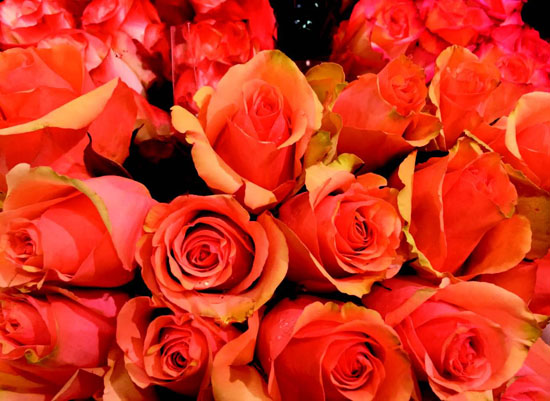 |
| Salmon and orange-hued roses are welcome gifts any time of year. |
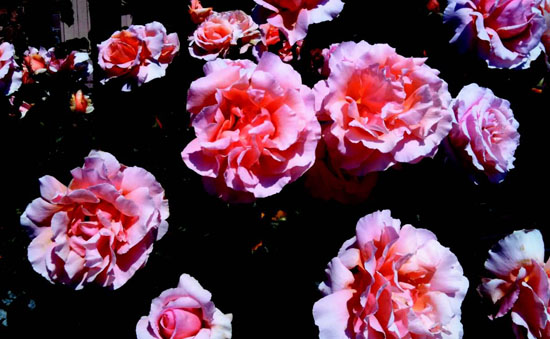 |
| A row of peach floribundas is a focal point of this landscape. |
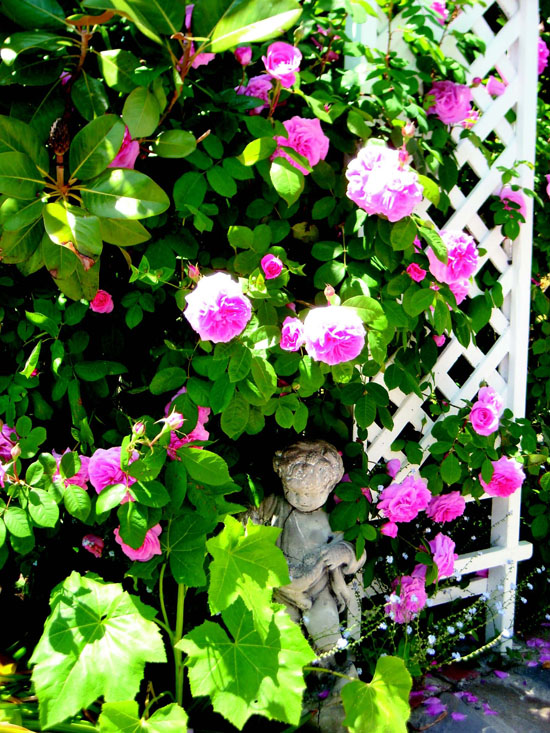 |
| A favorite climbing rose by David Austin Roses called Gertrude Jekyll. |
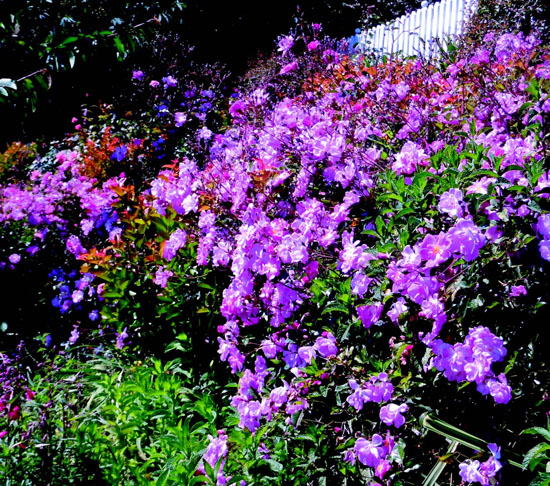 |
| Shrub roses, also called carpet roses, blanket this hillside with frilly blooms. |
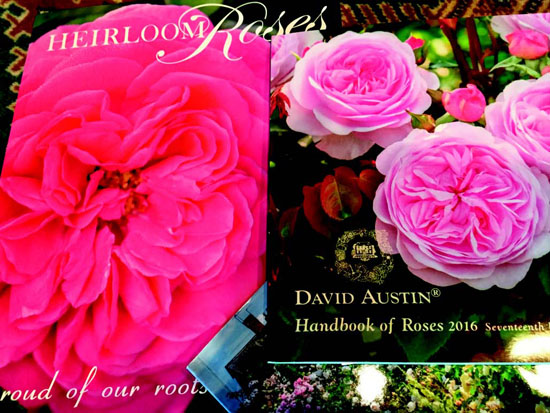 |
| Peruse rose catalogues for unique roses not found locally. |
 |
Cynthia Brian with an ever blooming grandiflora rose, Tournament of Roses
©2016
Cynthia Brian
The Goddess Gardener
Starstyle® Productions, llc
Cynthia@GoddessGardener.com
www.GoddessGardener.com
925-377-STAR
Tune into Cynthia’s Radio show at
www.StarStyleRadio.net
I am available as a speaker, designer, and consultant. |
| |
| |
|
|
|











